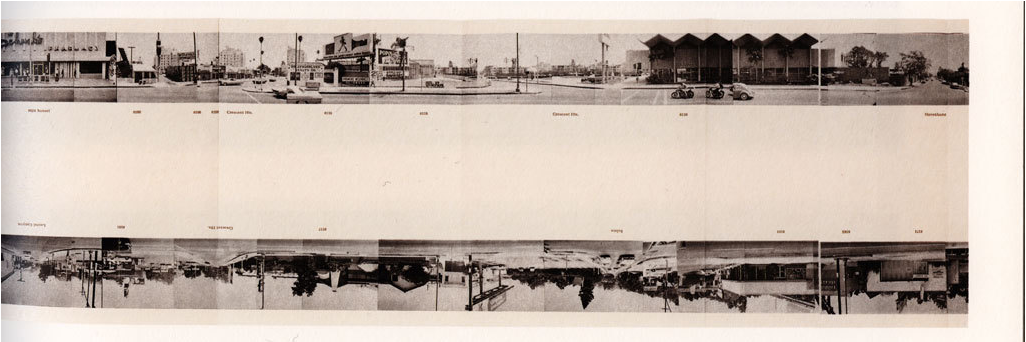Streetview Aesthetics?
In 1965, Ed Ruscha photographed Every Building on the Sunset Strip, in a way that may sound familiar to those following the Google Streetview release:
Ed Ruscha took the photographs contained in this leporello with a motorized Nikon camera mounted to the back of a pick-up truck. This allowed him to photograph every house on the Sunset Strip while driving – first down one side of the street and then the other. The pictures were then pasted in order, and the individual buildings were labeled with their respective house numbers.
There is so much to say about Streetview, luckily most of it does not involve any of the weird captures that have been all the rage lately (rivaling Loltheorists? no, but still pretty big). Then again, what seems so fascinating about Streetview is exactly its ‘Hey, look at this!’ value – even for relatively boring photographs – the same thing that keeps us uploading digital photos by the bucket to sharing sites like Flickr.
In an article at Slate, Michael Agger makes a very interesting point about Streetview, namely that it confronts us with an America that is perhaps not in line with previous perceptions. He notes how mundane and remote the streets are once you have access to them all at the same time:
[T]he streets of America are not exactly … alive. Classic urban encounters such as man-ogles-woman are difficult to find, while you can spend entire afternoons strolling down sunny, quiet suburban streets that could pass for outtakes from a Hopper painting.
Maybe it will only get worse now, with everyone inside scanning Google maps for the man urinating on a highway. Or maybe not. For now, two quick observations:
– Like Richard Rogers pointed out at Infowarrroom over the weekend, contemporary surveillance technologies are rushing us toward what Kevin Haggerty and Richard Ericson call the disappearance of disappearance (pdf). 360 degree camera shots made by nondescript Google vans with tinted windows make it abundantly clear that the anonymous flaneur is an endangered species. But at the same time, of course, the flaneur (or just voyeur?) is remade in virtual form – like Google says in defense of its new service, these are merely public pictures that anyone can make. Being a ‘stranger in one’s own city’ has never been easier.
– I think that Streetview drives home Erik Kluitenberg’s point that we live in a Society of the Unspectacular. On the one hand, Kluitenberg argues, technological ’emancipation’ has brought about an era that is far from extraordinary and better described as ultra-ordinary – ordinary to the extreme. The Web overflows with visual nonsense and cringe-worthy archives of uneventful events and unimaginably dull images (in response to Orwell: absolute power may be a drag, but absolute freedom is absolutely boring). On the other hand, and more importantly, the feverish uptake of new technologies and the need to capture and record is transforming subjectivity in ways we’re not yet able to pinpoint. That would mean that the ‘technosocial’ significance of Streetview, well beyond the privacy implications that have kept the weblogs busy so far, must still be thought through. (This understanding of ‘the Unspectacular’ is taken from a short talk given by Erik, also at Infowarroom. Hopefully something written will come along soon – an older, related piece of his is available here).
I’ll be content, though, with a Streetview/photoshop version of Ruscha’s original artwork. Who has a minute to throw it together?

